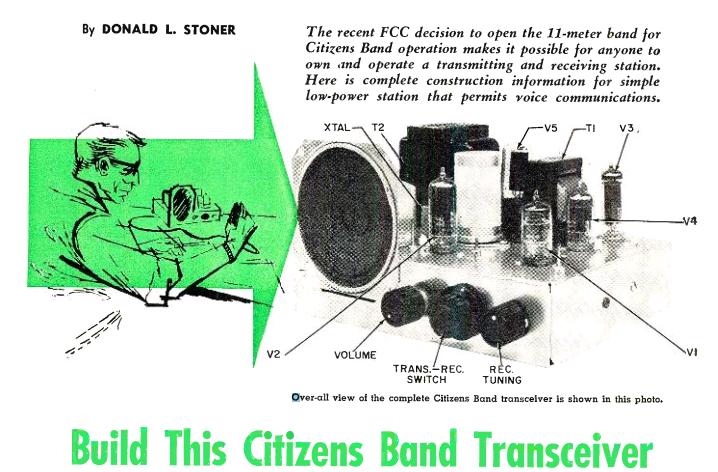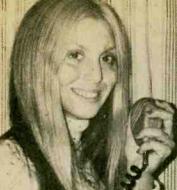In an earlier post, we saw the Heathkit CB-1 CB transceiver. The CB-1 was actually released before its more famous amateur radio cousins, the Sixer, Twoer, and Tener. And it turns out that the CB-1 was actually copied from a popular construction article.
I was unaware of this until I noticed an item in a 40 year old issue of Elementary Electronics magazine by CB radio editor Kathi Martin, KGK3916. In her column “Kathi’s CB Carousel” in the May-June 1975 issue, she talked enthusiastically about the FCC’s proposal to establish a “communicator” class of amateur radio license. The proposal was never adopted by the FCC, but Martin’s enthusiastic embrace of the proposal revealed what most hams believed to be true. Licenses would be “yours almost for the asking,” and would open up the two meter band to the unwashed code-free masses. And most tellingly, she admits what most hams already knew: The FCC proposal for the communicator license, “if read carefully, is CB.”
The proposal never went through, mostly because hams resisted it for exactly that reason. I’m sure I read her column 40 years ago, and if I did, I’m sure I was outraged by her frankness.
Time must have mellowed me a bit, since reading the article today, it is a good beginner’s look at what two meter FM was like in the 1970’s, and I can understand that CB’ers like Martin would have looked forward to the possibility of migrating from the bedlam that reigned on 11 meters in that era.
But I also noticed a reference that I hadn’t seen before: “If the CB clubs–and individual CB’ers–don’t louse things up with a big mouth [which apparently they did, since the proposal didn’t go through], we CB’ers are going to wind up with the best deal since Don Stoner’s magazine article ‘exposed’ class D CB to the general public–creating a billion-dollar industry.”
Having never heard of Don Stoner or his magazine article, I did some research and found it. She’s undoubtedly referring to a construction article that appeared in the March 1959 issue of Radio News. (Stoner was licensed as a ham as W6TNS, and was involved in the first OSCAR satellite.)
CB radio took over the former 11 meter ham band (which had only come into being after the war, and was shared with diathermy machines) on September 11, 1958. None of the major electronics magazines made much fuss about it initially. It doesn’t seem to be mentioned in Popular Electronics until the March 1959 issue. That article is a very matter-of-fact look at the new service, and a review of the few pieces of equipment that were then available. Electronics Illustrated carried a few articles about the new service in the June 1959 issue. In these articles, Electronics Illustrated went out of its way to stress that CB was not intended as a service for hobbyists nor as any kind of replacement for amateur radio.
Stoner’s article, however, announced the presence of the new bandwagon, and invited everyone to jump aboard. He enthusiastically starts:
Did you know that now you can build a radiotelephone transceiver and talk on a short-wave band without having to obtain an amateur radio license? The recent FCC decision to open the 11-meter band to Class D Citizens Band operation makes it possible for anyone (except those under 18 and aliens) to own and operate a short-wave transmitting and receiving station.
He then goes on to point out that 11-meter signals “can travel to the far corners of the earth. It is not at all uncommon to hear stations coming in from clear across the country every day during the winter and on most days during the summer.” He even concludes the article by wondering “who will be the first to issue a certificate for ‘Worked All States–Citizens Band (WASCB)?”
Whether or not the FCC intended it, Stoner certainly let the cat out of the bag as to the hobby potential of CB radio. And in the absence of much commercial equipment, he describes how to construct a 5-tube transceiver which is (with the exception of the power supply) identical to Heathkit’s later CB-1.
Even though the FCC probably didn’t intend it, Stoner was correct in his interpretation of the rules. Those original rules failed to include a number of provisions that were added in later years. For example, initially, licensees were allowed to build their own transmitters. There was no explicit prohibition on hobby use. And the restriction on maximum distance of communications did not appear in the initial rules. So Stoner was right, and someone could very well have offered a WAS-CB certificate, and this would have been a perfectly legitimate activity.
Stoner’s design was apparently popular, as evidenced by Heathkit’s wholesale adoption. In fact, it was so popular that the non-selective superregenerative receiver quickly became useless on the crowded band, and many of the CB-1’s were converted to six or two meters by hams.
(Any hams who are still bitter about the “loss” more than 50 years ago of a ham band that had only been theirs for a little over a decade should take note of one important fact: Stoner’s transceiver is quite simple. But it’s probably beyond the construction skills of most hams today. Yes, the CB’ers of 1959 were probably more technically adept than hams today.)
It appears that Kathi Martin was right in her 1975 column. The other electronics publications initially took a very cautious view of CB. But it looks like Stoner’s article really was the one that exposed the unwashed masses to the possibilities of CB.
(The QST announcement of the end of 11 meters for hams can be found in the QST archive.)
Click Here For Today’s Ripley’s Believe It Or Not Cartoon ![]()



Pingback: 1976 Temporary CB License | OneTubeRadio.com
Pingback: Kriket Kamel CB Mount, 1977 | OneTubeRadio.com
Pingback: 1958 Popular Electronics Two-Transistor Transmitter | OneTubeRadio.com
Pingback: Don Stoner, W6TNS, 1959 | OneTubeRadio.com